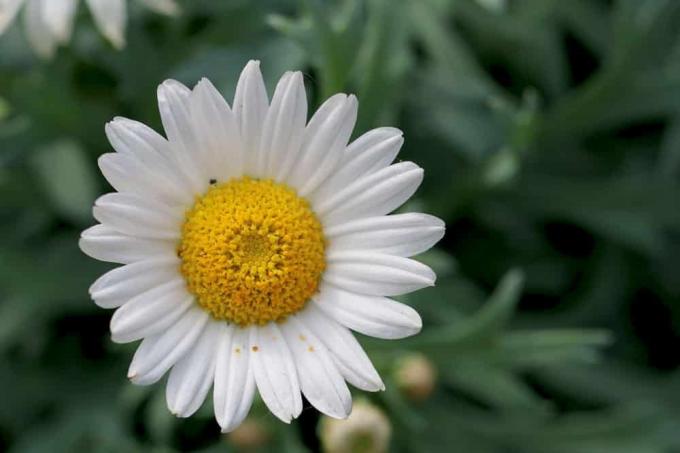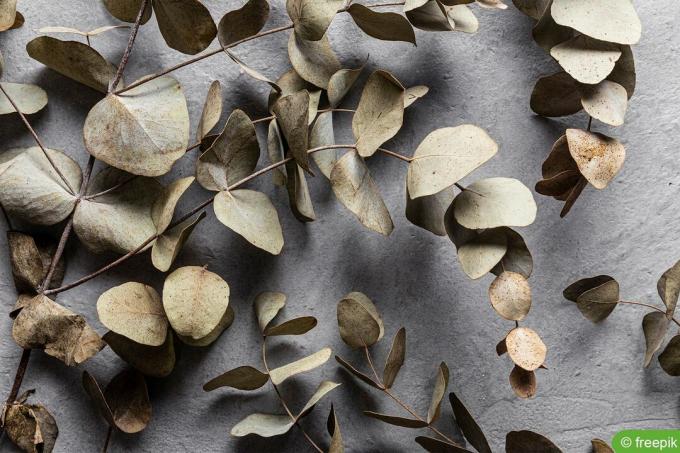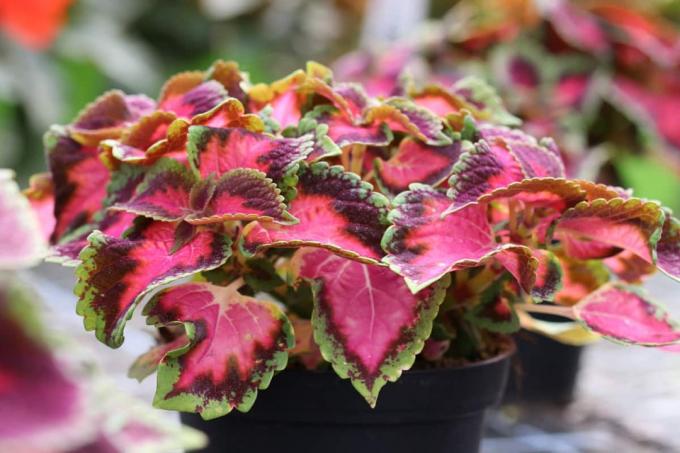

Table of contents
- Overwinter hardy daisies outdoors
- Preparatory actions
- Care in the cold season
- Not hardy daisies in the garden
- Overwintering of potted daisies
- The right time to move
- The optimal winter quarters
- Cut shrub daisies
- Cut daisy stems
- Care in winter quarters
- pest control
- End hibernation gently
Bushy daisies are waiting for us in garden centers just in time for spring. As if the life of this richly flowering plant had to begin anew every year. But that's not the case. There are some specimens that are not afraid of frost. They withdraw their power into the earth and wait for better days. The other species make themselves comfortable in the winter quarters.
Overwinter hardy daisies outdoors
Some varieties of marguerite are hardy. This has given them a permanent place in the garden. They are so well protected against the cold that they usually come into the new garden year healthy without any protection. Only in very cold regions or during bitterly cold winters are they thankful for a protective cover.
- cover with pine sticks
- a layer of fallen leaves also warms
- alternatively make jute or garden fleece makes the cold bearable
- prefer a sheltered location for new plantings
- as close to a wall as possible
Tip:
Hardy daisies are only completely safe from severe frost if they are dug out of the garden soil over the winter. After they have spent the uncomfortable time in a suitable quarter, they are allowed to spread out again directly in the garden soil in spring.
Preparatory actions
In autumn, the hardy daisies, which grow outside continuously, are prepared for the approaching winter. As a first measure, fertilizing will be stopped completely at the end of August. This means that the marguerite lacks nutrients for new growth. That's the intention. New shoots would not have enough time to mature and develop winter hardiness. Furthermore, a main cut is now due.
- cut before the first frosts
- with sharp scissors
- a hand's breadth above the ground
- Collect and discard leaves from the ground
During the winter, the plant retreats into the ground and only sprout in spring, as soon as the external conditions are more favorable for growth.
Care in the cold season
Winter is the time of absolute standstill. The marguerite, also known as the marigold, no longer grows at all. Therefore, no fertilizer is required. Casting is also almost completely stopped. However, moisture remains an important challenge even in winter. The soil in which the marguerite is stuck must not be too wet. Combined with cold, it is extremely harmful to the plant. This is precisely why a protected location is helpful. Loose soil that allows water to drain well also prevents waterlogging. However, if the winter does not rain for a very long time, the earth becomes dry. The marguerite doesn't like that very much either. In such a case, modest watering may also be used in winter.
Not hardy daisies in the garden
For frost-sensitive varieties, there are no suitable protective measures that allow them to survive the cold outdoors. They must be dug up for overwintering.
- dig up before the first frost
- plant in pots
- Overwinter with other potted plants
- in a safe neighborhood
- plant again in spring
Overwintering of potted daisies

Bushy daisies and daisy trunks in large pots are not uncommon. They decorate balconies, terraces or gardens. There you will find the ideal location for the summer. In winter they have to vacate this place if they want to survive the cold unscathed. Most of the specimens that grow in pots are not hardy anyway. Therefore, wintering in a sheltered room is an absolute requirement. At the beginning of September, weeks before the move, fertilizing should be stopped. Growth must come to a halt and the still fresh shoots must mature in good time.
The right time to move
In late autumn we often expect many warm and sunny days. It would be a shame to withhold this from Marguerite. Unfortunately, it is cold at night, frosts can even set in, which affect the marguerite. With a little work this can be mastered.
- Make it possible to stay outdoors for as long as possible
- Leave pots outside during the day
- bring in at night because of danger of frost
- “One night stopover” does not require any special conditions
- the most accessible space is optimal
- reduces heavy towing to a minimum
- however, the final move must take place around the end of October
- then definitely in a suitable winter quarters
The optimal winter quarters
A frost-free quarter alone is not good enough for the marguerite. She has other requirements when it comes to her winter home.
- it must be light
- but without the blazing sun
- with a temperature of 5 to 15 degrees Celsius
She will be too warm in most rooms of the house. Only a cool bedroom would be suitable. Garages and windowless basements are cool but also too dark. In it, they would form light green and thin shoots that cannot bear flowers. There are therefore only a few accommodation options left for the daisy:
- an unheated conservatory
- Glasshouse
- cool staircase with window
A notice:
Marguerites react sensitively to temperature fluctuations during their winter rest period. This should be avoided at all costs.
Cut shrub daisies
A heavily trimmed shrub daisy tends to dry out in the winter quarters. Therefore, the main cut should only be done in spring. Only a light cut is required just before the move. This only serves to keep the plant healthy. When pruning in autumn, everything that is superfluous or unnecessary in winter is removed. can harm the plant.
- cut before moving to winter quarters
- remove dried flowers and leaves
- Cut away all old flowering shoots
- also cut diseased or damaged parts
Cut daisy stems
Marguerite trunks are usually cultivated in tubs that only remain outdoors in the warm season. These decoratively shaped daisies are not hardy. The main pruning of the trunks is carried out in the fall, immediately before wintering. It is now important to keep evaporation to a minimum.
- no radical cut required
- Cut back all flowering shoots to the stem
- Shorten the remaining shoots by about a third
- remove diseased and injured shoots
- remove dry leaves from the shoots
A notice:
After hibernation, a corrective cut can be made, in which all disturbing shoots are removed.
Care in winter quarters
Plants should not be neglected in the winter quarters either. Although they don't grow, they require a minimum level of care to stay alive.
- no more fertilizing
- Water requirement is low
- let it dry until the leaves fall off
- then water only a little
- about every 2 to 4 weeks
- the colder the winter quarters, the lower the water requirement
- with soft, low-lime water
- the substrate should not dry out completely
- Spray the marguerite occasionally with lukewarm water
- slightly increase watering in spring
Tip:
If the daisy sprout during the winter, this is a sign of too much water. Reduce the amount of water to prevent premature sprouting.
pest control

The living conditions of the wildflowers change a lot in winter. The light intensity decreases, the temperatures drop. These challenges make the daisies more susceptible to pests. While the daisies are dormant, these little creatures can be very active.
- Plants should not be too close
- Check daisies regularly
- isolate affected plants
- Fight pests immediately
Tip:
Remove dead leaves from flower pots as soon as possible, as they encourage rot.
Prevention is of course the best protection. The more optimal the winter quarters are, the less often a pest infestation will appear.
- provide regular air exchange
- watch out for frost-free days
- Plants are not allowed to stand in the train
- increase humidity
- with humidifiers by spraying
End hibernation gently
The correct end of their hibernation is also part of the optimal hibernation of the daisies. The open air lures with the first rays of the sun, but nothing should be hasty. Before the great freedom comes a period of getting used to it.
- Do not put buckets out immediately
- slowly leading to warmer temperatures
- change location from March
- a little warmer, brighter and without direct sun
- pour some more
- fertilize “modestly” for the first time
- only from the middle of may it is safe outside
- the time of the night frosts is then over
Tip:
Now it's time for the main pruning of the daisy daisy. Necessary corrections can also be made to trunks with scissors.
 garden editorial
garden editorial I write about everything that interests me in my garden.
Learn more about overwintering plants

Eucalyptus dries up during the winter: what to do?
Eucalyptus in tubs spends the winter best in a frost-protected place in the house. It is not uncommon for the beautiful eucalyptus plants to dry up during the winter. We show what you can do about it.

Is bamboo hardy? Hibernate bamboo correctly
A bamboo can undoubtedly enrich any garden. But can it survive winter temperatures in good health? There is no general answer. It depends on the species and what winter protection it gets.

Is the colored nettle hardy? 6 tips for wintering
Summer is the season when the colors of these ornamental foliage plants are at their most intense. Most of the leaves are multicolored, with different drawings, wavy or heavily slit edges.

Is Camellia japonica hardy? Overwinter camellia properly
Anyone who sees a blooming camellia for the first time will definitely be amazed. The attractive plant, which came to Central Europe from Japan and Korea, has taken the hearts of hobby gardeners by storm. It is usually cultivated in tubs. Is she hardy?

Is the magic flower hardy? | Overwinter Mirabilis jalapa
The Japanese miracle flower (Mirabilis jalapa) delights its viewers with its bright and colorful flowers from June to October. It carries up to five different colored flowers on one and the same plant. Even a single flower can be multicolored.

Is rhododendron hardy? 6 tips for wintering
Overwintering rhododendrons: With these 6 tips you can get the azaleas through the winter safely!
